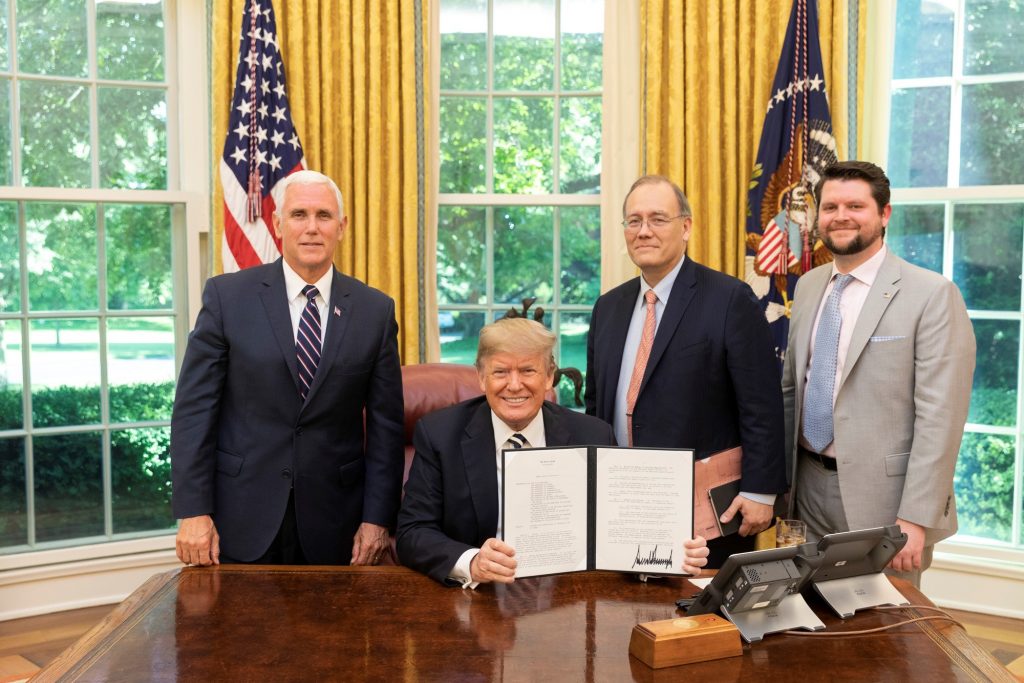Trump's New Space Policy Directive 2 Could Make Life Easier for SpaceX and Others

The Trump administration's push to ease regulations on private industry is no longer confined to Earth.
Yesterday (May 24), President Donald Trump signed Space Policy Directive-2 (SPD-2), which instructs the secretary of transportation to devise a new regulatory regime for launch and re-entry activities, and to consider requiring just a single license for all such commercial operations.
The document also orders the commerce secretary to review regulations on the commercial remote-sensing industry, and gives the secretary 30 days to come up with a plan to create a "one-stop shop" within the Commerce Department for private-spaceflight regulation. [In Photos: President Donald Trump and NASA]
"The president is committed to ensuring that the federal government gets out of the way and unleashes private enterprise to support the economic success of the United States," White House officials wrote in an SPD-2 fact sheet that was released yesterday.
The thrust of SPD-2 should come as no surprise, experts say. After all, the Trump administration has made it a priority to roll back or streamline regulations in many other parts of the economy, from banking to the energy industry.
"It is certainly consistent with an overall pro-business, deregulation approach of the Trump administration, applied to the space sector," said space policy expert John Logsdon, a professor emeritus of political science and international affairs at The George Washington University's Elliott School of International Affairs in Washington, D.C.
And SPD-2 started taking serious shape back in October 2017, at the first meeting of the newly resurrected National Space Council (NSC), Logsdon added.
Get the Space.com Newsletter
Breaking space news, the latest updates on rocket launches, skywatching events and more!
"One of the tasks was to develop a directive on regulatory reform," Logsdon told Space.com. "That's been in process, and it's been on Trump's desk for a while."
Major players in the private-spaceflight industry have been calling for regulatory reform for decades, and some of them — including SpaceX President and Chief Operating Officer Gwynne Shotwell — reiterated that request during testimony at the October NSC meeting.
"The council could commit to reforming, modernizing and streamlining federal regulations governing space launch," Shotwell told members of the council, which is chaired by Vice President Mike Pence. "Regulations written decades ago must be updated to keep pace with the new technologies and the high cadence of launch from the United States if we want a strong space launch industry here at home."
So Trump's signing of SPD-2 was a popular move in industry circles.
"This is a tremendous accomplishment by this administration on behalf of America's commercial space industry," Alan Stern, board chairman of the Commercial Spaceflight Federation, said in a statement.
"We've been innovating here at home and competing around the world under the burden of regulations written decades ago, in some cases rooted in the Cold War," added Stern, who's also the principal investigator of NASA's New Horizons Pluto mission. "Now we can foresee a more streamlined legal and administrative regime that will allow us to continue to help transform how Americans access and use space."
As its name suggests, SPD-2 is the Trump administration's second space policy directive. SPD-1, which Trump signed in December, formally instructs NASA to work toward returning astronauts to the moon, as a stepping stone to Mars.
Follow Mike Wall on Twitter @michaeldwall and Google+. Follow us @Spacedotcom, Facebook or Google+. Originally published on Space.com.
Join our Space Forums to keep talking space on the latest missions, night sky and more! And if you have a news tip, correction or comment, let us know at: community@space.com.

Michael Wall is a Senior Space Writer with Space.com and joined the team in 2010. He primarily covers exoplanets, spaceflight and military space, but has been known to dabble in the space art beat. His book about the search for alien life, "Out There," was published on Nov. 13, 2018. Before becoming a science writer, Michael worked as a herpetologist and wildlife biologist. He has a Ph.D. in evolutionary biology from the University of Sydney, Australia, a bachelor's degree from the University of Arizona, and a graduate certificate in science writing from the University of California, Santa Cruz. To find out what his latest project is, you can follow Michael on Twitter.